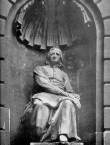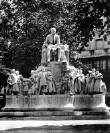Painting and Sculpture in the Second Half of 19th Century

Sculpture could not rival with painting which began to flourish producing a richness never seen before, although significant developments took place in sculpture, too. Trips to academies were general practice, Vienna and Munich being the cities where Hungarian sculptors mostly learnt.
Architecture invited more artists to decorate buildings with ornaments and figures. Dancers, one of the most significant sculptural decorations by Károly Alexy for the Vigadó (Municipal Concert Hall) built by Feszl, increase the effect of the richly decorated building. The same applies to the Hungarian Academy of Sciences built by Stüler, an architect from Berlin, and monumental reliefs by Miklós Izsó modelled great personalities of science.
Doors and balconies of practically all buildings were decorated with figures, hermas and caryatids. Most of them were, however, stucco decorations, sometimes produced with machines. Only few of them were products of stone cutters.
Memorials in public places, a new genre in comparison with decorative sculpture, became general in the 19th century, but Hungary was a country where it had no antecedents at all, thus its achievements are to be very highly appreciated in comparison with those of neighbouring countries. Sovereigns, statesmen and poets of the nation were commemorated, and towns growing into cities erected their sculptures in public places. Smaller and more intimate plastic art was also flourishing at the time, Izsó being the only major artist, but it has only secondary importance with respest to monumental sculpture.
Miklós Izsó (1831-1875) was the most peculiar personality of the time. He was the first and the only artist for a long time that raised Hungarian sculpture with a strong popular-national approach to the level of Hungarian art which can be related with that of Petőfi and Arany in literature, or Erkel and Liszt in music. His art was not appreciated and he died of tuberculosis at an early age. However, his realized works made him a significant artist of the late 19th century. (See details on the art of Izsó on separate page.)
Adolf Huszár (1843-1888) was one of the most popular sculptors of his time. In spite of skills in modelling and composition, he was not an outstanding artist. The statue of Ferenc Deák (1887) in Budapest is a good example of fascinating openness and formal composition. The untimely death of Huszár prevented him from finishing the statue which was then completed by Alajos Stróbl, the most significant sculptor at the turn of the century.
Besides other minor sculptors of memorials, János Fadrusz (1858-1903) was the most significant one in the last third of the 19th century. He maintained his individual style which was not influenced by historism. His main work is the statue of King Matthias (1895-1902) erected in Kolozsvár Fadrusz was not merely a master of monumental sculpture but an artist who discovered and amalgamated new paths and streams. (See details on the art of Fadrusz on separate page.)
Although the oeuvre of György Zala and Alajos Stróbl outgrew the period discussed, their style represented mainly the late 19th century. This is why they are included in this chapter.
György Zala (1858-1937) attended the best academies of the time, his skills and sense of monumentality were outstanding but pathos and pose never let him become an impressive artist. His best statue was that of Gyula Andrássy (1893) erected beside the Parliament in Budapest. It was, however, demolished when the Kossuth Bridge was built. Elegant and lively, impressive and picturesque, it united man and animal in a harmony. His major work was the Millennium Monument (1894) at the end of the one-time Sugár út which is rather theatrical: it makes quite an impression with the livelihood of figures (e.g. the figures of War and Peace in a carriage pulled by galloping horses). The architecture of the monument was entrusted to Albert Schikedanz. In the case of the Millennium Monument which took a long time to finish (it was ready by 1920 only) architecture and sculpture are more in harmony with one another than was the case in most of works of the time. Zala who worked much all his life accepted all commissions. His art, however, was best at small size portraits and genre groups.
 Alajos Stróbl (1856-1926) was a more fascinating personality. Although he was related to Zala, his works can be characterised as being open and convincing which make his works authentic. In his works qualities are accepted which might be objected to in the case of another artist. The best example for this is the Matthias Fountain (1902) with groups of figures as if a wax-works show on the wall of Buda Castle. His skills at sculpture are best represented in his early Self-Portrait (1878) where delicate details and well-controlled proportions catch the eye. Our Mother (1892-1896) is another good example of his art: the delicate figure of an old woman is sitting with her back humped, she is lost in her thoughts. Love towards her is expressed: he failed to complete many more works of this standard. His statues erected in public places reflect official expectations and have theatrical features of baroque, the only exception being perhaps the statue of János Arany (1895) erected in front of the Hungarian National Museum. Its contours with almost musical harmony, and the attractive figure of the poet makes the beholder forget the somewhat unrefined figures at the pedestal.
Alajos Stróbl (1856-1926) was a more fascinating personality. Although he was related to Zala, his works can be characterised as being open and convincing which make his works authentic. In his works qualities are accepted which might be objected to in the case of another artist. The best example for this is the Matthias Fountain (1902) with groups of figures as if a wax-works show on the wall of Buda Castle. His skills at sculpture are best represented in his early Self-Portrait (1878) where delicate details and well-controlled proportions catch the eye. Our Mother (1892-1896) is another good example of his art: the delicate figure of an old woman is sitting with her back humped, she is lost in her thoughts. Love towards her is expressed: he failed to complete many more works of this standard. His statues erected in public places reflect official expectations and have theatrical features of baroque, the only exception being perhaps the statue of János Arany (1895) erected in front of the Hungarian National Museum. Its contours with almost musical harmony, and the attractive figure of the poet makes the beholder forget the somewhat unrefined figures at the pedestal.
József Róna (1861-1939), a sculptor of monuments, was a popular master of sculptural decoration. Of his works, the statue of Eugene de Savoie erected in front of the former Royal Palace in Budapest is to be mentioned here. In spite of pompous details and baroque pathos, its liveliness makes Róna a real master. The sculpture of Ede Kallós (1866-1950) is cooler but more sincere than that of Róna. He worked together with Ede Telcs, his junior by some years. Their best known work is the statue of poet Vörösmarty in Budapest. There are a lot of oversize side figures on the pedestal: although they are characteristic figures, they cannot be considered as perfect artistic solutions.
In spite of pompous details and baroque pathos, its liveliness makes Róna a real master. The sculpture of Ede Kallós (1866-1950) is cooler but more sincere than that of Róna. He worked together with Ede Telcs, his junior by some years. Their best known work is the statue of poet Vörösmarty in Budapest. There are a lot of oversize side figures on the pedestal: although they are characteristic figures, they cannot be considered as perfect artistic solutions.
 Alajos Stróbl (1856-1926) was a more fascinating personality. Although he was related to Zala, his works can be characterised as being open and convincing which make his works authentic. In his works qualities are accepted which might be objected to in the case of another artist. The best example for this is the Matthias Fountain (1902) with groups of figures as if a wax-works show on the wall of Buda Castle. His skills at sculpture are best represented in his early Self-Portrait (1878) where delicate details and well-controlled proportions catch the eye. Our Mother (1892-1896) is another good example of his art: the delicate figure of an old woman is sitting with her back humped, she is lost in her thoughts. Love towards her is expressed: he failed to complete many more works of this standard. His statues erected in public places reflect official expectations and have theatrical features of baroque, the only exception being perhaps the statue of János Arany (1895) erected in front of the Hungarian National Museum. Its contours with almost musical harmony, and the attractive figure of the poet makes the beholder forget the somewhat unrefined figures at the pedestal.
Alajos Stróbl (1856-1926) was a more fascinating personality. Although he was related to Zala, his works can be characterised as being open and convincing which make his works authentic. In his works qualities are accepted which might be objected to in the case of another artist. The best example for this is the Matthias Fountain (1902) with groups of figures as if a wax-works show on the wall of Buda Castle. His skills at sculpture are best represented in his early Self-Portrait (1878) where delicate details and well-controlled proportions catch the eye. Our Mother (1892-1896) is another good example of his art: the delicate figure of an old woman is sitting with her back humped, she is lost in her thoughts. Love towards her is expressed: he failed to complete many more works of this standard. His statues erected in public places reflect official expectations and have theatrical features of baroque, the only exception being perhaps the statue of János Arany (1895) erected in front of the Hungarian National Museum. Its contours with almost musical harmony, and the attractive figure of the poet makes the beholder forget the somewhat unrefined figures at the pedestal.

 In spite of pompous details and baroque pathos, its liveliness makes Róna a real master. The sculpture of
In spite of pompous details and baroque pathos, its liveliness makes Róna a real master. The sculpture of